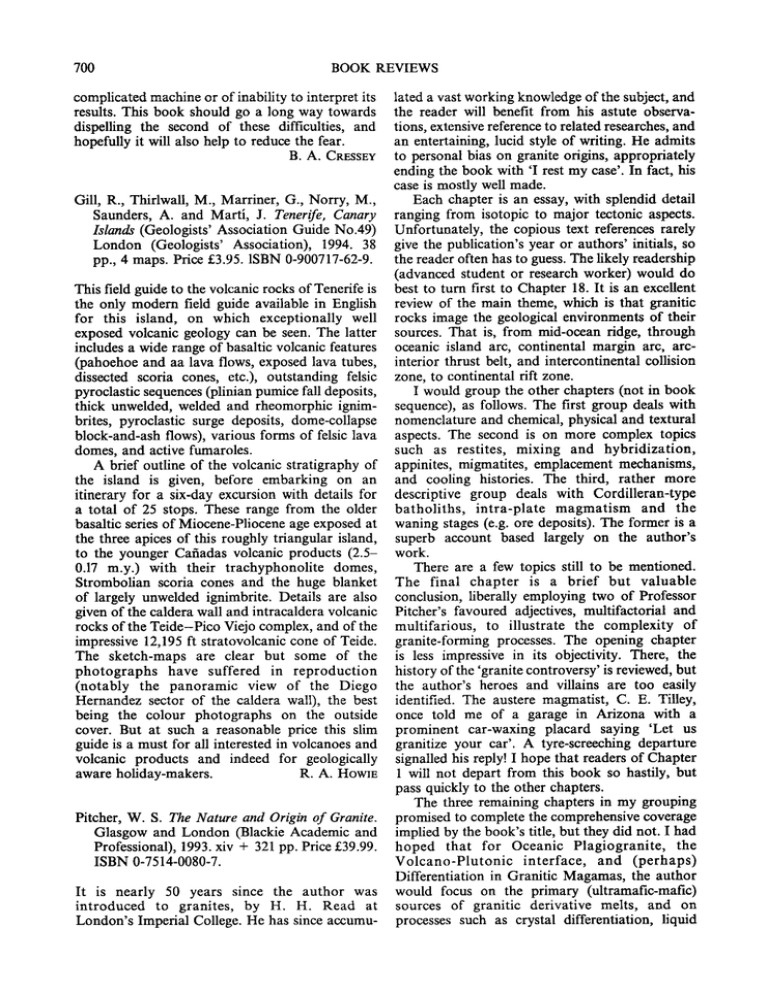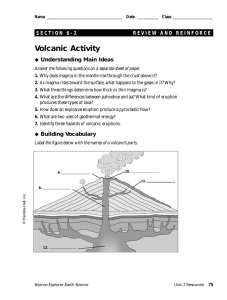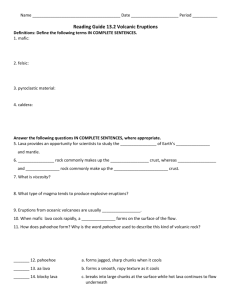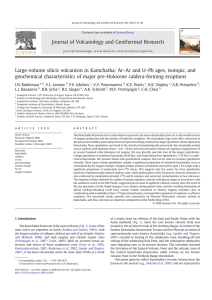Pitcher, W. S. The Nature and Origin of Granite.
advertisement

700 BOOK REVIEWS complicated machine or of inability to interpret its results. This book should go a long way towards dispelling the second of these difficulties, and hopefully it will also help to reduce the fear. B. A. CRESSEY Gill, R., Thirlwall, M., Marriner, G., Norry, M., Saunders, A. and Marti, J. Tenerife, Canary Islands (Geologists' Association Guide No.49) London (Geologists' Association), 1994. 38 pp., 4 maps. Price s 0-900717-62-9. This field guide to the volcanic rocks of Tenerife is the only modern field guide available in English for this island, on which exceptionally well exposed volcanic geology can be seen. The latter includes a wide range of basaltic volcanic features (pahoehoe and aa lava flows, exposed lava tubes, dissected scoria cones, etc.), outstanding felsic pyroclastic sequences (plinian pumice fall deposits, thick unwelded, welded and rheomorphic ignimbrites, pyroclastic surge deposits, dome-collapse block-and-ash flows), various forms of felsic lava domes, and active fumaroles. A brief outline of the volcanic stratigraphy of the island is given, before embarking on an itinerary for a six-day excursion with details for a total of 25 stops. These range from the older basaltic series of Miocene-Pliocene age exposed at the three apices of this roughly triangular island, to the younger Cafiadas volcanic products (2.50.17 m.y.) with their trachyphonolite domes, Strombolian scoria cones and the huge blanket of largely unwelded ignimbrite. Details are also given of the caldera wall and intracaldera volcanic rocks of the Teide-Pico Viejo complex, and of the impressive 12,195 ft stratovolcanic cone of Teide. The sketch-maps are clear but some of the photographs have suffered in reproduction (notably the panoramic view of the Diego Hernandez sector of the caldera wall), the best being the colour photographs on the outside cover. But at such a reasonable price this slim guide is a must for all interested in volcanoes and volcanic products and indeed for geologically aware holiday-makers. R . A . HowlE Pitcher, W. S. The Nature and Origin of Granite. Glasgow and London (Blackie Academic and Professional), 1993. xiv + 321 pp. Price s ISBN 0-7514-0080-7. It is nearly 50 years since the author was introduced to granites, by H. H. Read at London's Imperial College. He has since accumu- lated a vast working knowledge of the subject, and the reader will benefit from his astute observations, extensive reference to related researches, and an entertaining, lucid style of writing. He admits to personal bias on granite origins, appropriately ending the book with 'I rest my case'. In fact, his case is mostly well made. Each chapter is an essay, with splendid detail ranging from isotopic to major tectonic aspects. Unfortunately, the copious text references rarely give the publication's year or authors' initials, so the reader often has to guess. The likely readership (advanced student or research worker) would do best to turn first to Chapter 18. It is an excellent review of the main theme, which is that granitic rocks image the geological environments of their sources. That is, from mid-ocean ridge, through oceanic island arc, continental margin arc, arcinterior thrust belt, and intercontinental collision zone, to continental rift zone. I would group the other chapters (not in book sequence), as follows. The first group deals with nomenclature and chemical, physical and textural aspects. The second is on more complex topics such as restites, mixing and hybridization, appinites, migmatites, emplacement mechanisms, and cooling histories. The third, rather more descriptive group deals with Cordilleran-type batholiths, intra-plate magmatism and the waning stages (e.g. ore deposits). The former is a superb account based largely on the author's work. There are a few topics still to be mentioned. The final chapter is a brief but valuable conclusion, liberally employing two of Professor Pitcher's favoured adjectives, multifactorial and multifarious, to illustrate the complexity of granite-forming processes. The opening chapter is less impressive in its objectivity. There, the history of the 'granite controversy' is reviewed, but the author's heroes and villains are too easily identified. The austere magmatist, C. E. Tilley, once told me of a garage in Arizona with a prominent car-waxing placard saying 'Let us granitize your car'. A tyre-screeching departure signalled his reply! I hope that readers of Chapter 1 will not depart from this book so hastily, but pass quickly to the other chapters. The three remaining chapters in my grouping promised to complete the comprehensive coverage implied by the book's title, but they did not. I had hoped that for Oceanic Plagiogranite, the Volcano-Plutonic interface, and (perhaps) Differentiation in Granitic Magamas, the author would focus on the primary (ultramafic-mafic) sources of granitic derivative melts, and on processes such as crystal differentiation, liquid







